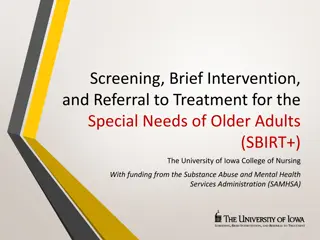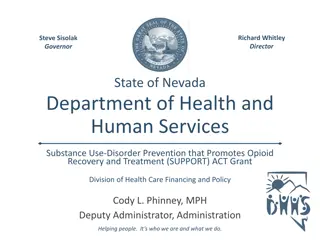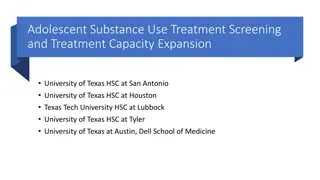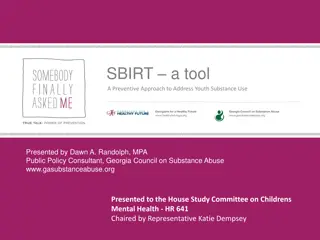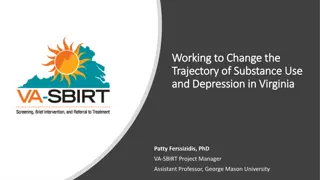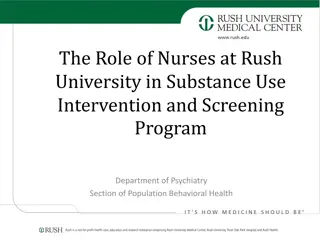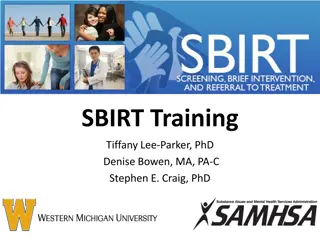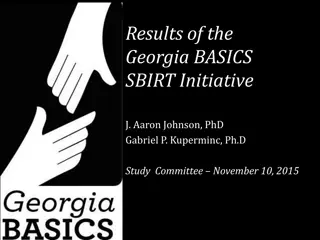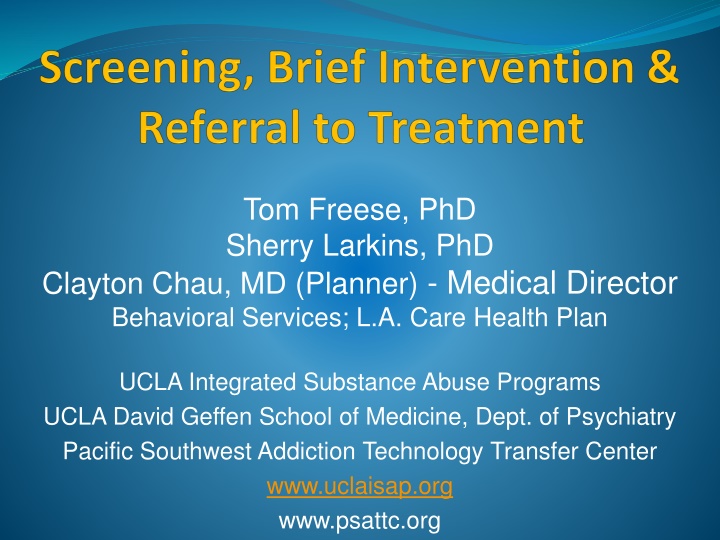
Screening and Brief Intervention in Behavioral Health
Learn about screening and brief intervention techniques in behavioral health to identify substance use problems early, provide brief counseling, and facilitate access to specialized care. Discover the importance of SBI in addressing substance abuse issues effectively and efficiently.
Download Presentation

Please find below an Image/Link to download the presentation.
The content on the website is provided AS IS for your information and personal use only. It may not be sold, licensed, or shared on other websites without obtaining consent from the author. If you encounter any issues during the download, it is possible that the publisher has removed the file from their server.
You are allowed to download the files provided on this website for personal or commercial use, subject to the condition that they are used lawfully. All files are the property of their respective owners.
The content on the website is provided AS IS for your information and personal use only. It may not be sold, licensed, or shared on other websites without obtaining consent from the author.
E N D
Presentation Transcript
Tom Freese, PhD Sherry Larkins, PhD Clayton Chau, MD (Planner) - Medical Director Behavioral Services; L.A. Care Health Plan UCLA Integrated Substance Abuse Programs UCLA David Geffen School of Medicine, Dept. of Psychiatry Pacific Southwest Addiction Technology Transfer Center www.uclaisap.org www.psattc.org
Disclosure: Tom Freese, PhD Sherry Larkins, PhD Clayton Chau, MD Do not have financial relationships to disclose -and will not discuss off label use and/or investigational use in the presentation 2
Increase knowledge of screening and brief intervention concepts and techniques Review Screening Steps Review Brief Intervention Techniques 1. 2. 3.
Screening: Very brief set of questions that identifies risk of substance use related problems. Brief Intervention: Brief counseling that raises awareness of risks and motivates client toward acknowledgement of problem. Referral: Procedures to help patients access specialized care.
A Public Health Solution: Screening, Brief Intervention (SBI) Excessive drinking, illicit drug use, and prescription drug misuse are often undiagnosed by medical professionals. Substance abuse leads to significant medical, social, legal, financial consequences. Treatment GAP Why SBI? The brief intervention itself is inherently valuable, and positive screens may not require referral to specialty treatment. Early, brief interventions are clinically effective and cost- efficient. 5
SBIRT Severe Problem Users Hazardous & Harmful Users SBIRT Non-Users or Low Risk Users
2M people (0.8%) receiving treatment* 21M people (7%) have problems needing treatment, but not receiving it* 60-80M people ( 20-25%) using at risky levels US Population: 307,006,550 US Census Bureau, Population Division July 2009 estimate *NSUDH, 2008
In treatment (2 Million) Diagnosable problem with substance use Referred to treatment by:* Self/Family Criminal Justice Other SUD Program County Assessment Center 37% 25% 8% 19% 3% 8% Healthcare Other *Los Angeles County Data
In need of treatment (21 Million) Reported problems associated with use Not in treatment currently 1.1% Made an effort to get treatment 3.7% Felt they needed treatment, but made no effort to get it. Approx. 95% Did not feel that they needed treatment
Using at risky levels (60-80 Million) These people need services, but will never enter the treatment system Do not meet diagnostic criteria Level of use indicates risk of developing a problems. Some examples Drinks 3-4 glasses of wine a few times per week Pregnant woman occasionally has a shot of vodka to relieve stress Adolescent drinking with his friends on weekends Drinks and takes vicodin to help with pain
Brief interventions trigger change. A little counseling can lead to significant change, e.g., 5 min. has same impact as 20 min. SBI can reduce accidents, injuries, trauma, emergency department visits, depression, drug- related infections and infectious diseases Can save $ - SBI for alcohol saves $2 - $4 for each $1.00 expended Research is less extensive for illicit drugs, but promising. See reference list
Screening, Brief Interventions for Alcohol: Major Impact of SBI on Morbidity and Mortality Study Reference Results - conclusions Trauma patients 48% fewer re-injury (18 months) 50% less likely to re-hospitalize Gentilello et al, 1999 Hospital ER screening Reduced DUI arrests 1 DUI arrest prevented for 9 screens Schermer et al, 2006 Physician offices 20% fewer motor vehicle crashes over 48 month follow- up Fleming et al, 2002 Meta-analysis Cuijpers et al, 2004 Interventions reduced mortality Burke et al, 2003 Treatment reduced alcohol, drug use Positive social outcomes: substance-related work or academic impairment, physical symptoms (e.g., memory loss, injuries) or legal problems (e.g., driving under the influence) Meta-analysis Interventions can provide effective public health approach to reducing risky use. Whitlock et al, 2004 Meta-analysis
Screening, Brief Interventions for Alcohol: Saves Healthcare Costs Study Authors Cost Savings Randomized trial of brief treatment in the UK Reductions in one-year healthcare costs $2.30 cost savings for each $1.00 spent in intervention (UKATT, 2005) Project TREAT (Trial for Early Alcohol Treatment) randomized clinical trial: Screening, brief counseling in 64 primary care clinics of nondependent alcohol misuse Reductions in future healthcare costs (Fleming et al, 2003) $4.30 cost savings for each $1.00 spent in intervention (48-month follow-up) Randomized control trial of SBI in a Level I trauma center Alcohol screening and counseling for trauma patients (>700 patients). Reductions in medical costs $3.81 cost savings for each $1.00 spent in intervention. Gentilello et al, 2005)
Coding for Screening and Brief Intervention Reimbursement Fee Payer Commercial Insurance Code CPT 99408 Description SBI (15-30 minutes) Schedule $33.41 Commercial Insurance CPT 99409 SBI (Greater than 30 minutes) SBI (15-30 minutes) $65.51 Medicare G00396 $29.42
Coding for Screening and Brief Intervention Reimbursement Fee Payer Medicare Code G0397 Description SBI (Greater than 30 minutes) Alcohol screening (only) SBI (per 15 minutes) Schedule $57.69 Medicaid H0049 $24.00 Medicaid H0050 $48.00
Drinking Guidelines Men: No more that 4 drinks on any day and 14 drinks per week Women: No more than 3 drinks on any day and 7 drinks per week Men and Women >65: No more than 3 drinks on any day and 7 drinks per week NIAAA, 2011 285 ml Beer 12 oz 100 ml Wine Fortified Wine 5 oz 60 ml 30 ml Liquor 1.5 oz 3.5 oz
Awareness of problem Behavior change Motivation Presenting problem Screening results
Step 1: Screening to Identify Patients At Risk for Substance Use Problems
SBI Procedures: Follow-up Action Depends on Score Pre-Screening Negative Screen Positive screen Positive Reinforcement AUDIT Screen Moderate/High Use Abuse/Dependence Brief Intervention/ Brief Treatment Referral to Treatment
MI - The Spirit: Clinician Nonjudgmental and collaborative Based on consumer and clinician partnership Gently persuasive More supportive than argumentative Listens rather than tells Communicates respect and acceptance for consumers and their feelings Resistance is met with reflection
MI - The Spirit: Client Responsibility for change is left with the client Change arises from within rather than being imposed from without Emphasis on client s personal choice for deciding future behavior Focus on eliciting the client s own concerns
Where do I start? What you do depends on where the consumer is in the process of changing The first step is to be able to identify where the consumer is coming from
1. Precontemplation Definition: Not yet considering change or is unwilling or unable to change. Primary Task: Raising Awareness 6. Recurrence Definition: Experienced a recurrence of the symptoms. 2. Contemplation Definition: Sees the possibility of change but is ambivalent and uncertain. Primary Task: Cope with consequences and determine what to do next Primary Task: Resolving ambivalence/ Helping to choose change Stages of Change: Primary Tasks 5. Maintenance Definition: Has achieved the goals and is working to maintain change. 3. Determination Definition: Committed to changing. Still considering what to do. Primary Task: Develop new skills for maintaining recovery Primary Task: Help identify appropriate change strategies 4. Action Definition: Taking steps toward change but hasn t stabilized in the process. Primary Task: Help implement change strategies and learn to eliminate potential relapses
SUD MH Legal Issues SUD Family Medical Issues
L Listen & Understand O Options Explored F Feedback W Warn Avoid Warnings! (that s it)
Setting the stage Feedback Tell screening results Explore pros & cons Explain importance Listen & understand Assess readiness to change Discuss change options Options explored Follow up
F Feedback O Options Explored L Listen & Understand
The Feedback Sandwich Ask Permission Give Advice Ask for Response
What do you say? 1. Range of score and context - Scores on the AUDIT range from 0-40. Most people who are social drinkers score less than 8. 2. Results- Your score was 18 on the alcohol screen. 3. Interpretation of results - 18 puts you in the moderate- to-high risk range. At this level, your use is putting you at risk for a variety of health issues. 4. Norms - A score of 18 means that your drinking is higher than 75% of the U.S. adult population. 5. Patient reaction/feedback - What do you make of this?
Listen for the Change Talk Maybe drinking did play a role in what happened. If I wasn t drinking this would never have happened. Using is not really much fun anymore. I can t afford to be in this mess again. The last thing I want to do is hurt someone else. I know I can quit because I ve stopped before. Summarize, so they hear it twice!
The good things about ______ The not- so- good things about ____ The not-so- good things about changing The good things about changing Avoid questions that inspire a yes/no answer.
Importance/Confidence/Readiness On a scale of 1 10 How important is it for you to change your drinking? How confident are you that you can change your drinking? How ready are you to change your drinking? For each ask: Why didn t you give it a lower number? What would it take to raise that number? 1 2 3 4 5 6 7 8 9 10
What now? What do you think you will do? What changes are you thinking about making? What do you see as your options? Where do we go from here? What happens next?
Offer a Menu of Options Manage drinking/use (cut down to low-risk limits) Eliminate your drinking/drug use (quit) Never drink and drive (reduce harm) Utterly nothing (no change) Seek help (refer to treatment)
At follow-up visit: Inquire about use Review goals and progress Reinforce and motivate Review tips for progress See reference list
Approximately 5% of patients screened will require referral to substance use evaluation and treatment. A patient may be appropriate for referral when: Assessment of the patient s responses to the screening reveals serious medical, social, legal, or interpersonal consequences associated with their substance use. These high risk patients will receive a brief intervention followed by referral. See reference list
Describe treatment options to patients based on available services Develop relationships between health centers, who do screening, and local treatment centers Facilitate hand-off by: Calling to make appointment for patient/student Providing directions and clinic hours to patient/student Coordinating transportation when needed
Thank you for your participation! Thomas E. Freese, Ph.D tfreese@mednet.ucla.edu Sherry Larkins, Ph.D. larkins@ucla.edu




